Skateboarding got its origin in the United States, has got popularity all over the world. It is a sport played using a wooden deck, with 2 pairs of wheels fixed near either end of the board. Skateboarding was a modification of sea surfing. It was earlier known as sidewalk surfing. A person riding a skateboard would place one foot on the skating board and by giving a force by pushing the other foot on the floor, the wheels in the skateboard get its movement. There are varieties of tricks performed by skateboarders. Some budget-friendly skateboards for beginners are available in the market. In this article, let’s learn some interesting facts about skateboards like knowing how to tell the front and back of a skateboard, nose and tail differences, and some tips for beginners.
Anatomy Of Skateboard
For those who are new to skateboarding, it would be good to know the various parts of the skateboard and its functionality.
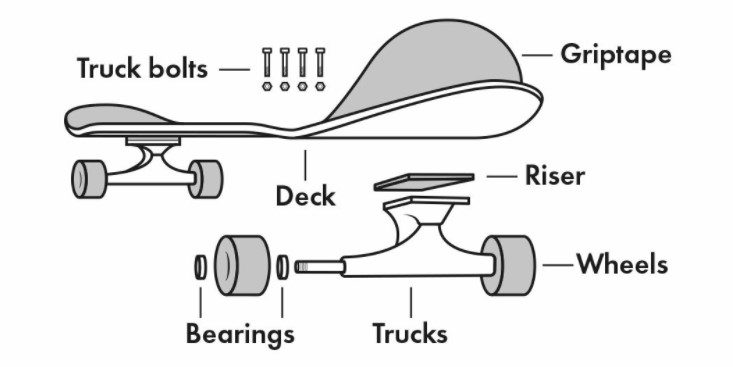
Skateboard Decks
Skateboard decks are made from layered plies of maple wood and get laminated. The basic part of the skateboard is the wooden deck which has a size ranging from less than 7 inches to more than 8 inches. Here the size denotes the width of the skateboard. Wider decks are considered to be more stable while narrow decks are preferred for performing more tricks and technical experiments on them.
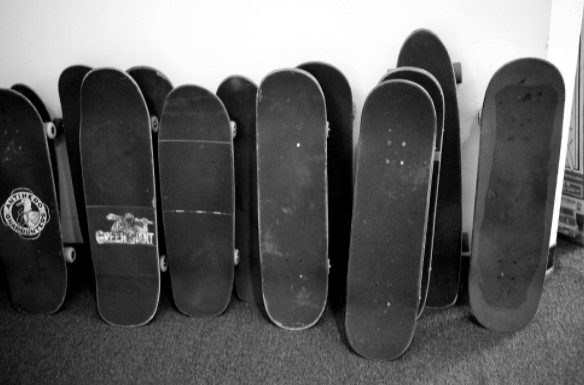
The wooden deck is of two types as per their shape. Choice of the skateboard shape depends on the surface on which the skateboard is used. The most common one is the popsicle stick. It is more preferred for skating and doing tricks. Directional skateboard shapes can be used in skateparks or streets.
The curved shape in the ends of the skateboard is known as concave. More the concave, better will be the pop whereas lesser concave will give a swift and responsive pop. The front of the skateboard is known as the nose and the back is known as the tail.
Grip Tape
Grip tape is a sticker with a rough surface like that of sandpaper, sticking it on the skateboard would provide better grip while skating and doing tricks. Grip tapes are available in plain black colors and with a variety of designs and colors. Grip tapes are of standard size.
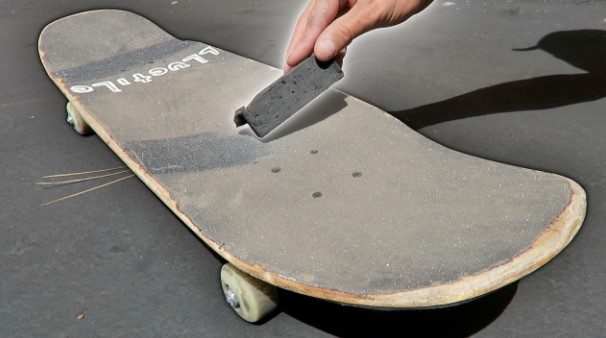
Buy a preferred grip tape, remove the paper in the back of the grip tape, and place it carefully on the skateboard in a way that from the center of the skateboard place it gradually on the whole board. Gently press the grip tape on the board from the center to the edges of the board. It should be done slowly to eliminate the air bubbles.
Press the skateboard thoroughly to remove air bubbles if any. If even after pressing, some air bubbles are present, then remove the grip tape and repeat the process one more time and try to get it done without air bubbles. Give a press using a screwdriver vertically, on the edges of the skateboard to get the shape of the board thereby easy to trim the excess grip tape that is out of the board. Using a paper cutting knife, trim it carefully along the edges starting from nose to tail of the board to get the correct curves and exact shape of the skateboard.
From that cut excess paper, get a small piece, and rub it on the edges of the skateboard which would provide a smooth finish and it will ensure that the tape is firmly fixed and will not be peeled off. Flip the board and take a screwdriver, clear the grip tape that is covering the holes in which the trucks are to be fixed using nuts and bolts.
Trucks
Using trucks the wheels are fixed on the deck of the skateboard. Trucks of the skateboards are made of steel. They are available based on their height, in three sizes, low, medium, and high. Low-sized trucks are suitable for beginners as they have lesser height, balancing will be easy. Med or medium is the commonly used size, which suits all.

Skaters who are fond of cruising rather than performing tricks prefer a high truck. The truck has a hanger that is extended with an axle. A base plate upon which is a pivot cup and a kingpin and a nut that is used in kingpin. Unscrew the kingpin, place the washer, bottom bush, hanger, top bush, and washer in chronological order upon the kingpin and place the hanger in such a way that it is seated in the pivot cup. Screw the nut firmly on the kingpin.
The next step is to fix the wheels and bearings. We need four wheels and two bearings for every wheel and so eight bearings are needed. Bearings help the wheels to rotate freely on the axle. Fixing the kingpin nut tightly will allow the skater to have a nice pop, and fixing it loose will help turn better. Soft bushes help in better turning and hard bush provides resistance and helps for a quick pop. Know the difference between front and back skateboard trucks. For both the trucks, place it in the way that the kingpin must be facing the middle of the skateboard.
How To Tell The Front And Back Of A Skateboard?
For a beginner, it would be difficult to identify the front and back of the skateboard. There are some easy tricks to find it. Generally, the front side is known as the nose of the skateboard, which is narrow and steep compared to the tail which is a little flatter than the nose.
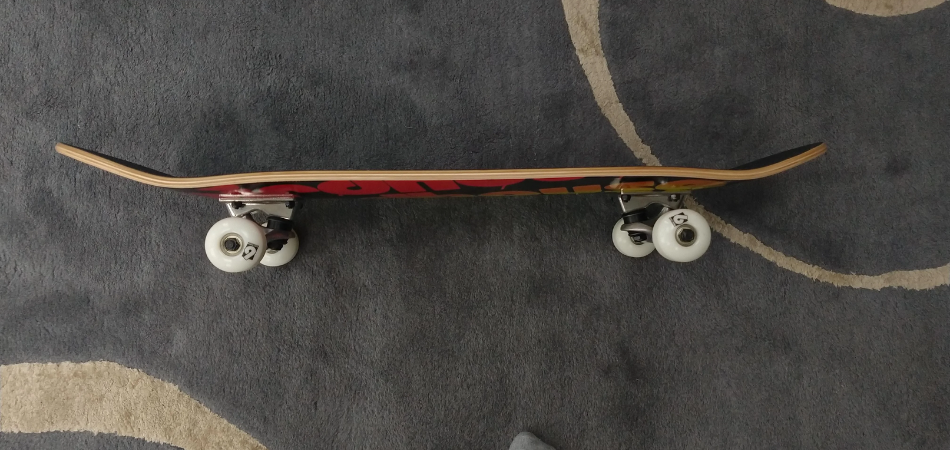
An easy way to identify the front and back or the nose and tail is that you can see the graphics at the bottom of the skateboard. If it is a vertical graphic then it’s easy, the head is nose and the bottom is tail. If it’s a horizontal graphic then the right side is the nose and the left side is the tail of the skateboard. The other way to find it out is to take a measuring tape.
From the tip to the concave take the measure on both the ends. The nose will be a little longer than the tail. But when you head out with your board, it’s not possible to do these things to know the front and back. So make a marking on the hardware of the board with different colors or stick some stickers or something that would help to identify the nose and tail of the board at just a look.
Over time, the skater would easily know the front and back as practiced with the board. Knowing front and back is important. While skating one should place the front foot by the nose and the back foot by the tail.
Does It Matter Which Way Your Skateboard Faces?
In general practice, the nose of the skateboard facing forward while skating is more common. There are two variations: regular and goofy. What makes the difference is which foot is comfortable for you to keep first on the board. If you feel comfortable having your left foot first on the board, then you are comfortable with the regular stance and if having your right foot first on the board makes you more comfortable then it is a goofy stance.
The deciding factor of the stance to be followed is comfort. Both the stances are equally good and nothing can be said better than the other. If you are not clear about what stance is more convenient for you, then take a slide test. If you slide on a slippery floor, which foot of yours comes first, that is out of instinct which foot comes first, that would be the decider of the stance.
But giving a try for both the stances would eventually make you know the stance that suits you best. On the other hand, skating with a tail in the forward position is known as fakie. Beginners may get confused with the switch stance and fakie stance. A switch stance is the just opposite of the normal stance that is placing the comfortable foot back, whereas a fakie is a stance in which the comfortable foot is placed front but the tail is facing front, not the nose.
Getting the first skateboard that is budget-friendly is the best thing about skateboarding for a beginner. There are a variety of cost-friendly beginner skateboards available in the market. For a kid around 5 or 6 years, a less-weight board made of a plastic cruiser, ready-to-use perfectly assembled skateboards like Maketec 22 inch skateboard would be suitable. KPC pro skateboard is another fast-moving brand. It has graphic designs suitable for both boys and girls, and aluminum decks.
The skateboard is not assembled. We have to assemble it. ‘BELEEV’ beginners’ skateboard is a brand considered as a good longboard for a beginner. Kryptonics, chrome wheels are some of the other budget-friendly skateboards available in the market. While considering the cost, it is equally important to consider the safety of the rider. Electronic skateboards are also available. The speed of the board is controlled by a remote. A beginner can even try an electric skateboard with a remote.
Skateboard Riding Tips For Beginners
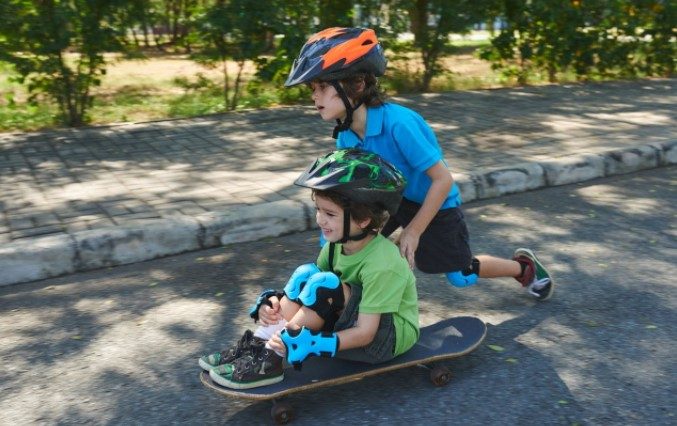
- Getting familiar with the board and riding it is the first step in skateboarding. Without knowing the basics a beginner should not try to do tricks.
- Practice makes any sport or art perfect. So, a beginner should never hesitate to go to a skatepark and to give it a try. Never mind the comments and remember every pro was once a beginner.
- To get acquainted with the board first you should practice standing on the board with a good balance. Your standing position is shoulders parallel to the board. Placing your foot parallel to the shoulder will give you more balance. Another easy way is to place the feet on either side of the hardware that is used to fit the trucks.
- Once you are confident in standing on the board, then learn pushing. Maintain your weight concentrated on the front foot at the center of the board, then slightly change the gravity to the back foot and give a push on the floor to make a move.
- As a beginner, the next thing to learn is to pick up the board. Bending every time to pick up the board is not advisable. Practice picking up the board and it will give better coordination with the board.
- Throwing down the board is the next step. Running slowly by throwing the board and jumping onto it will give a good momentum, and once learned to do this, the skater would feel comfortable.
- After cruising comfortably, a beginner can try for an ollie. Try standing next to a curb and practice well. Once comfortable in doing ollie you can try during a ride. Then practice riding down from a curb.
- Cracks on the way are more common. It is not pretty to stop or hit in a crack. You should know how to avoid it by lifting off your weight from the front trucks and making a jump on the back foot. Practice will perfect it.
- With improved confidence, you can try the switching stance.
- Learn to stop the board comfortably by doing a nose pick-up or any other method that suits you.
Conclusion
A skateboard is a sport that gives immense pleasure to one. There is no age limit for learning to skateboard. Only true desire is needed to master the sport. As a beginner from knowing how to tell the front and back of the skateboard to different kinds of a stance of skateboarding are made easy to understand.